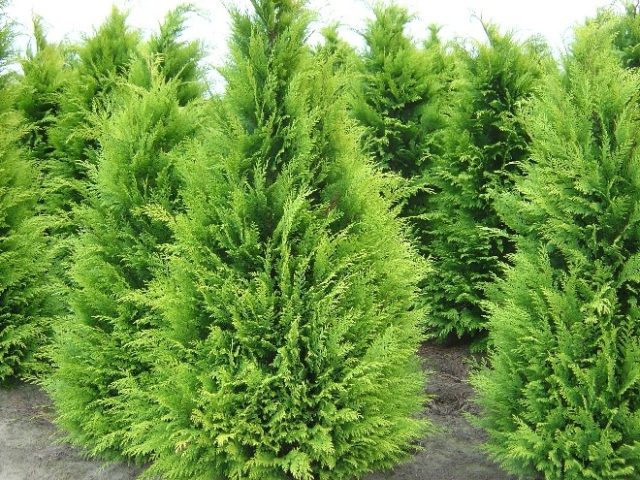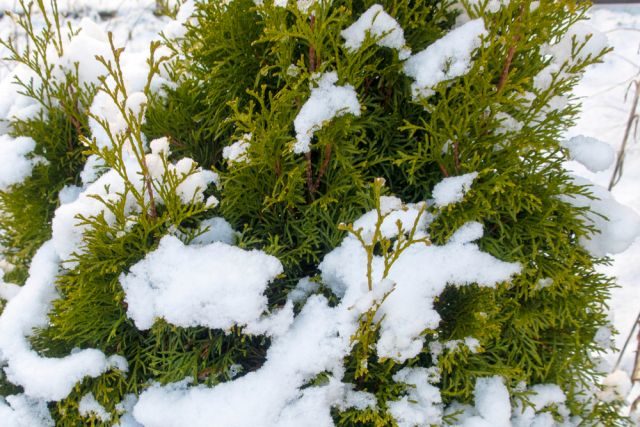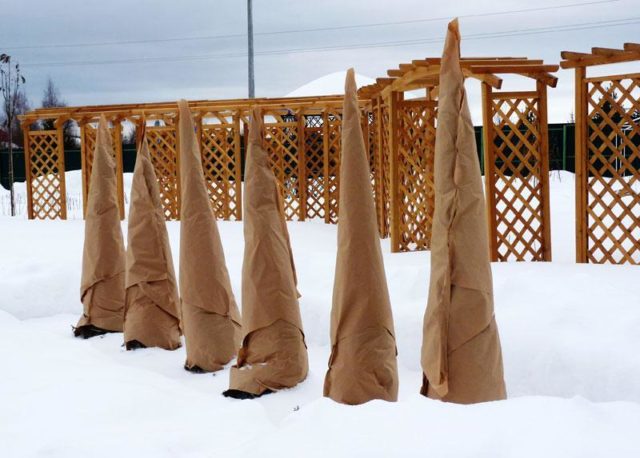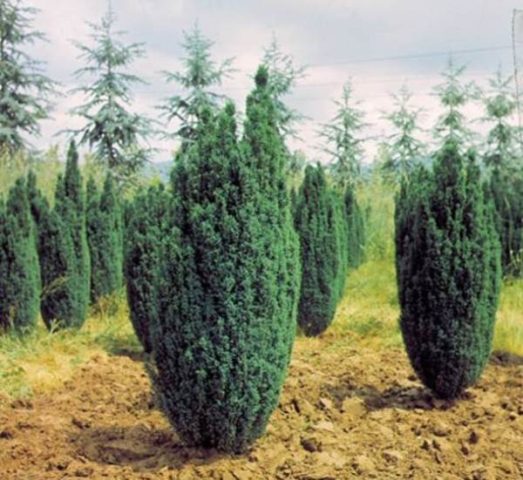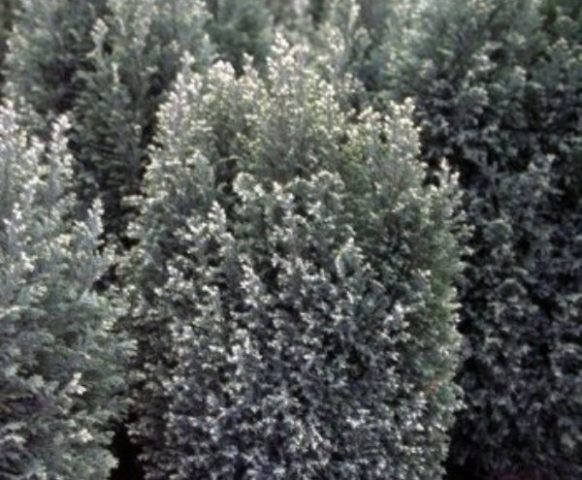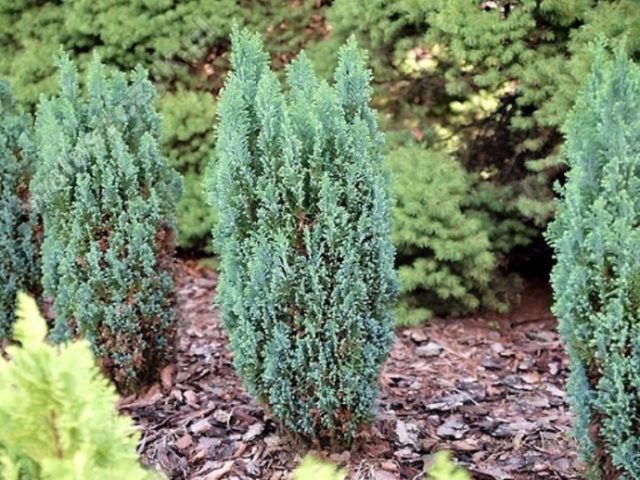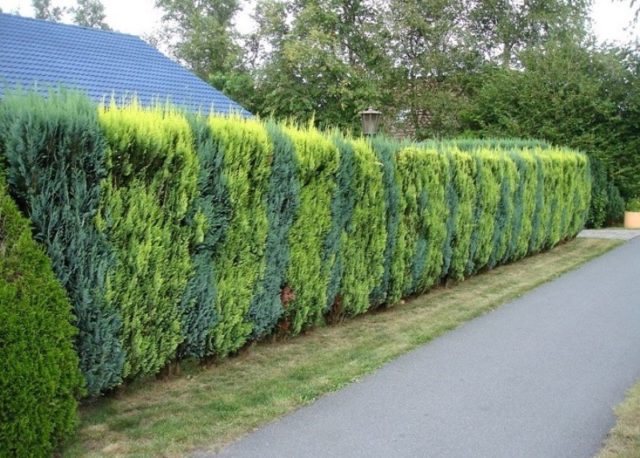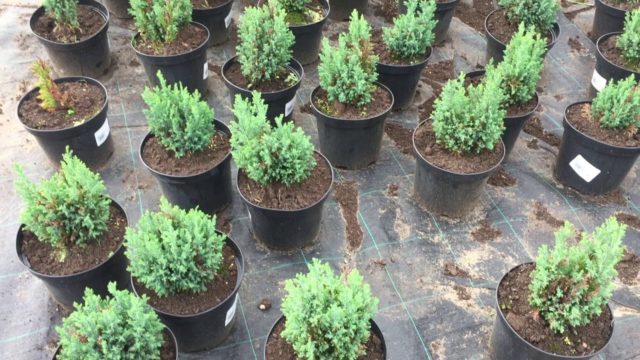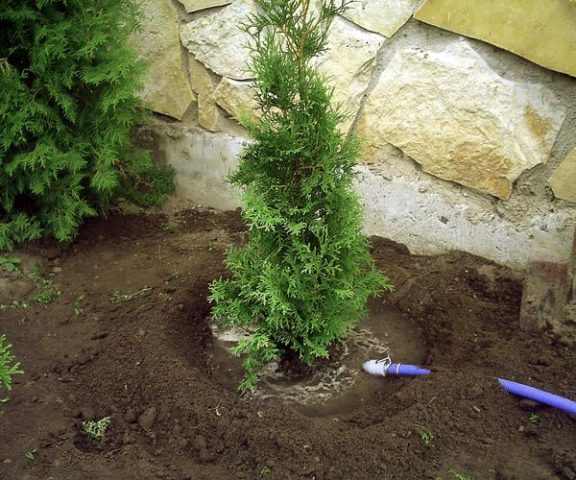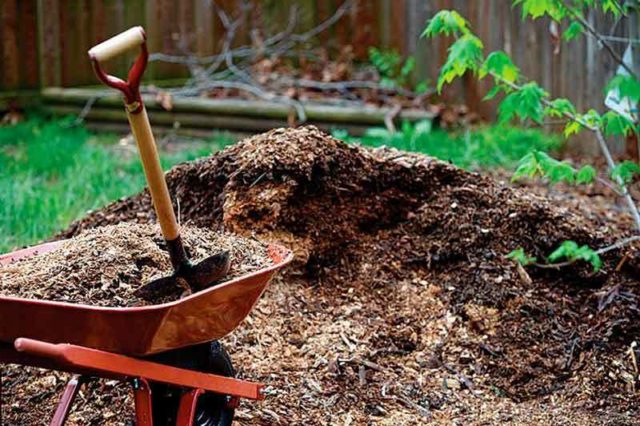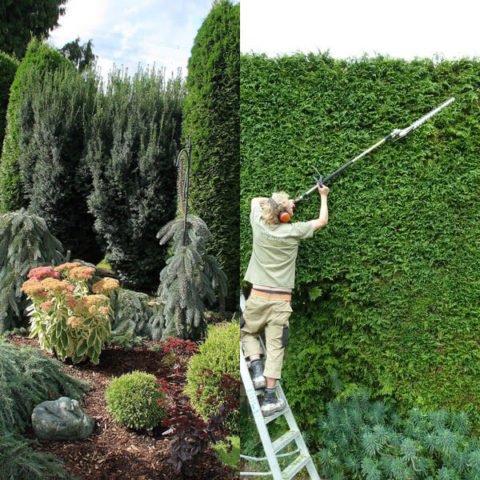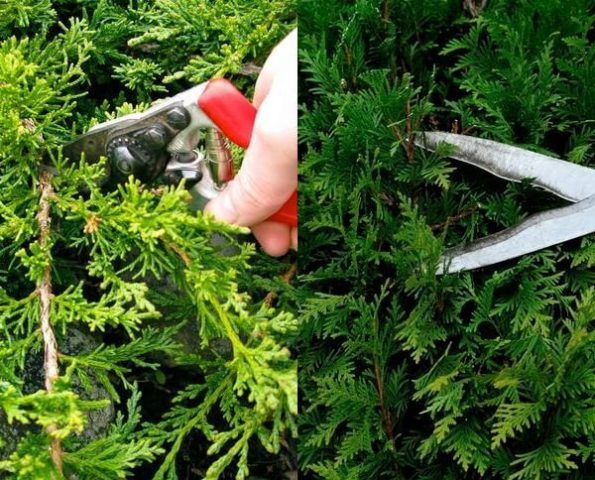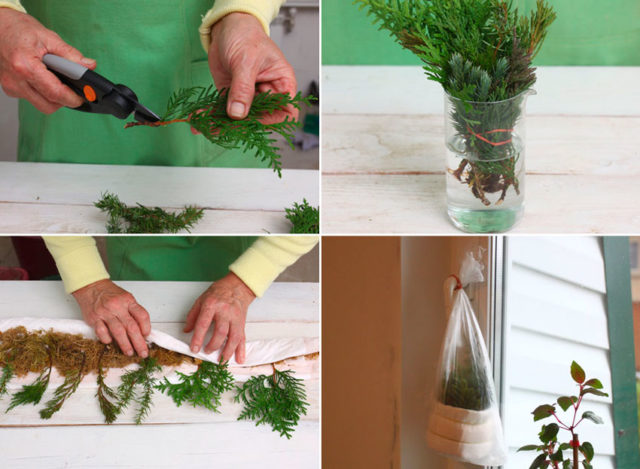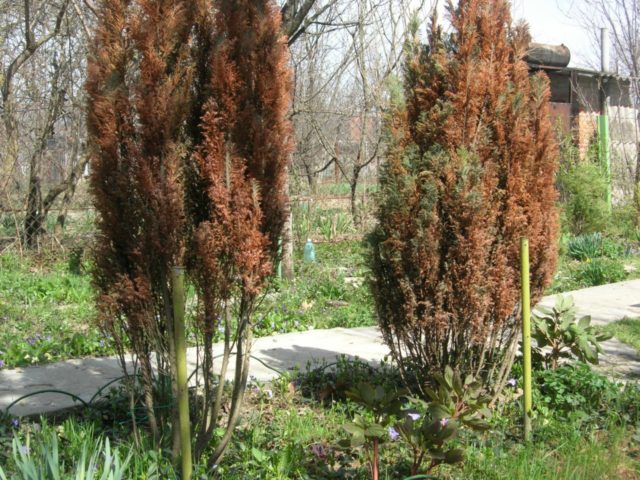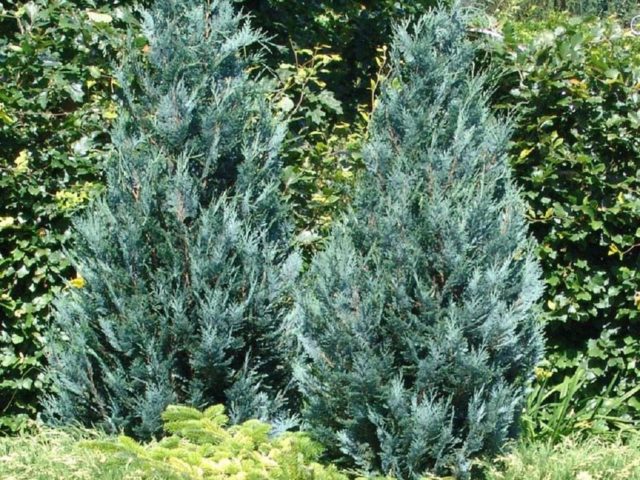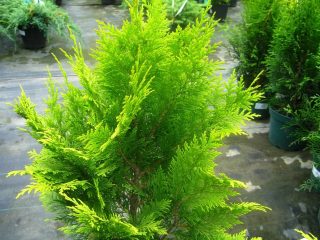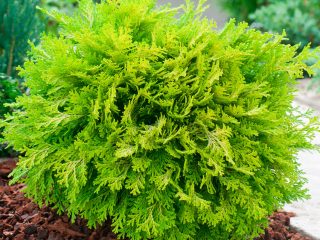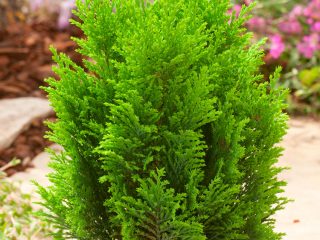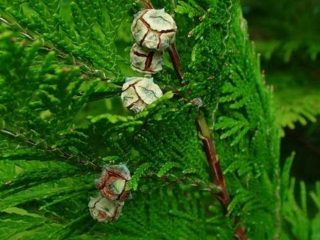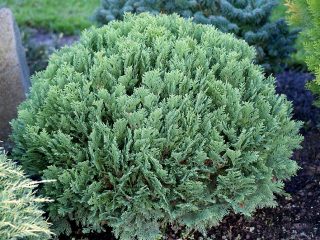Content
Coniferous crops are especially popular. Most of them do not lose their decorative properties in winter, have phytoncidal properties and improve the physical and psychological state of a person by their very presence on the site. Among the conifers there are frost-resistant northern plants and gentle southern ones. Caring for the Elwoodi cypress, native to California and Oregon, at home is not simple. The plant is poorly adapted for life in a harsh climate, but if you try hard, it can be grown in Russia.
Description of Lawson Elwoodi cypress
Lawson's cypress or Lawson's cypress (Chamaecýparis lawsoniána) is an evergreen gymnosperm (coniferous) tree, a species of the genus Cypress, belonging to the Cypress family. The culture is preserved in nature only in northwestern California and southwestern Oregon, where it grows at an altitude of 1500 m in coastal mountain valleys. In other areas of North America, Lawson's cypress was destroyed due to total cutting down. Its wood is not subject to rotting, light and fragrant, yellowish in color.
The species Lawson's cypress looks attractive, but grows very large. To date, several compact varieties have been developed. One of the most popular in Russia is the Lawson Elwoodi cypress, grown as a houseplant and in open ground.
The variety appeared in 1920 and was first described 9 years later. It grew from the seed of a Lawson's cypress in Swanpark, UK.
Elwoodi is an evergreen, upright tree that differs in appearance when young and mature. First, the plant forms a dense crown in the shape of a cone with vertical branches pressed tightly against each other. Thin feathery needles are bluish-green, evenly colored, hard, needle-like.
When the Elwoodi cypress grows, the crown becomes loose and wide, without losing its conical shape. The ends of the shoots and the tops droop. The scales on the needles become softer and the color becomes uneven. In the depths of the plant, green colors predominate, on the periphery - bluish, with a steel tint. Side shoots on vertical branches of a mature tree sometimes grow parallel to the ground. They can even lie on the ground if the lower part is not exposed by pruning.
Often the Elwoodi cypress grows into several trunks, which is why it forms 2-3 tops of different heights. This does not spoil the appearance of the plant, but the tree becomes like a bush. This is clearly visible in the photo of the Lawson Elwoodi cypress tree, which has reached three meters in height.
Elwoodi cypress is a monoecious plant, the tree has both male and female flowers that appear in the spring. After pollination, round scaly cones with a diameter of up to 1.2 cm are formed, greenish with a blue tint, and ripening in one year.
The root system is superficial, well developed. The bark is reddish brown. With age, it cracks and delaminates into plates.
Frost resistance of Lawson Elwoodi cypress
The crop can grow without shelter in climate zone 6B, where the minimum winter temperature is in the range of -20.6-17.8⁰ C. But when planting Elwoodi cypress on a plot, one must take into account that the young plant still needs protection for the first 3 years.
In other regions, the variety can tolerate warm winters well. But even a single drop in temperature below a critical level can destroy the Elwoodi cypress. It should be noted that the needles suffer in winter and at seemingly far from critical temperatures. This occurs due to dryness of the vegetative organs and sunburn, and not due to their freezing.
Elwoody White cypress with creamy white tips has satisfactory frost resistance, not inferior to the original variety.But after winter, the light parts often turn brown. This is not a disease, it’s just that the white tips of conifers are prone to freezing. To preserve decorativeness, the affected parts are cut off in the spring.
Regions with harsh climates also have warm winters. It happens that Elwoodi cypress grows in a plot without shelter or problems for several seasons, and then suddenly dies. This development of events must be taken into account, and one must focus not on the expected weather forecast for the winter, but on climatic conditions. When the twenty-degree frost hits, it will be too late to cover the cypress tree.
Winter shelter for Elwoodi cypress
Even in zone 6B, Elwoodi cypress needs to be covered if it grows in a windy area so that the plant does not die from drying out the needles. First, the crown is tied with twine or rope, then wrapped in lutrasteel, agrofibre, white spandbond and tied. In this position, the needles will evaporate less moisture, which will at least somehow protect it from drying out. The white material reflects sunlight, and this will protect the Elwoodi cypress from overheating and damping out under cover if the temperature rises for a while.
The soil is covered with a layer of mulch at least 15 cm thick. The area of soil coverage should be equal to the width of the crown of the Elwoodi cypress - that is how much space the root system takes up.
Dimensions of Lawson Elwoodi cypress
Lawson's cypress lives in the wild for 600 years or more, grows up to 70 m, and its trunk diameter can be 1.8 m.It is precisely because of its gigantic size that the tree has not become widespread in culture. But the Lawson Elwoodi cypress variety, whose plant height does not reach more than 3.5 m, is often used in landscape design, especially in countries with mild climates.
This tree develops very slowly. At the age of 10 years, the height of the Elwoodi cypress is only 1.0-1.5 m. Often even a mature plant does not exceed 2 meters. The crown width is 0.6-1.2 m. To make the Elwoodi cypress more attractive, several cuttings are often planted close to each other. Then it becomes like a large bush, growing into several trunks and forming 2-3 peaks. The crown becomes thicker and wider.
Of course, the Elwoodi cypress looks beautiful, but it requires careful care. There are few branches inside the “bush”, but they still grow. Without access to sunlight, the shoots dry out over time; if they are not cleaned and cut out, spider mites and other pests will settle there over time. But it is difficult to remove small insects from conifers. So sanitary pruning and cleaning will have to be done several times a season.
Elwoodi cypress can be grown as a houseplant. Indoors it will reach a more modest size than outdoors - 1-1.5 m.
Lawson Elwoodi cypress varieties
There are several forms of the Elwoodi cypress variety, differing in the size of the tree and the color of the needles. All of them can be grown in open ground and as indoor plants.
Lawson cypress Elwoodi Empire
Description of the Lawson cypress Elwoodi Empire differs from the original form primarily in its compressed, compact needles and dense short branches raised upward.It grows a little lower, even under the most favorable conditions it reaches no more than 3 m. The green cypress needles of this variety have not a blue tint, but a blue tint.
Grown in landscape groups as a hedge or a single focal plant.
Lawson cypress Elwoodi Gold
This form of cypress is characterized by a compact size - no higher than 2.5 m, and golden needles. The current year's growth is especially bright in color; the color fades with age. Therefore, it seems that the light green diamonds are decorated with a gold border.
The Elwoody Gold cypress variety requires planting in a location with more sun exposure than the original form. With a lack of light, the yellow color fades, and in deep shadow it disappears completely.
Lawson Cypress Elwoody White
This form is even more compact in size than the original. The height of the Elwoody White (Snow White) cypress at the age of 20 years is only 1 meter, width - 80 cm. The crown is compact, the shoots are erect, dense, but not as much as that of the Empire variety.
The needles are gray-green, creamy at the tips, as if touched with frost. This cypress requires planting in a bright place or light partial shade, otherwise the variegated vegetative organs will become monochromatic. The variety is suitable for open ground, growing in outdoor containers and as a houseplant.
Cypress Elwoodi Pilar
Another compact variety of cypress, although not as miniature as the previous one. Elwoodi Pilar reaches its maximum size at the age of 20 years, when its height is 100-150 cm. At 10 years, the cypress tree grows to 70-80 cm. The crown is narrow, columnar, the shoots are straight, the needles of adult plants are blue-green, those of young plants are bluish.
Planting Lawson Elwoodi cypress
If you carefully choose where to plant your Elwoodi cypress, care will be easier. Before placing it on the site, you need to find out in what conditions the crop prefers to grow in order to recreate them with maximum accuracy.
Cypress requirements for growing conditions
This variety as a whole is quite shade-tolerant, but with a strong lack of sunlight, the needles lose their additional color and become simply green. The Gold and Snow White varieties have the greatest lighting requirements.
But you shouldn’t plant Elwoodi cypress in direct sunlight in the southern regions - this will dry out the needles, which are already suffering from a lack of moisture in the air. It is enough for the tree to be well lit 6 hours a day, preferably in the morning.
The soil under the Elwoodi cypress should be loose, moderately fertile, and acidic. If necessary, humus and sand are added to the soil before planting. To increase acidity, high-moor (red) peat is used. Its structure is fibrous; it not only adjusts the pH of the soil in accordance with the requirements of cypress, but also increases its permeability.
If there is a fountain or pond on the site, the tree is planted as close to it as possible, since the air humidity there is higher than in other places.
Elwoodi cypress cannot be grown on soaking soils or where groundwater comes close to the surface. Despite the increased requirements for moisture and the root system spreading wider rather than deeper, the cypress tree may die.
Selection of seedlings or why cypress does not take root
Seedlings brought from local nurseries take root well - they are better adapted than Polish or Dutch ones. An additional danger for cypress is that it does not tolerate drying out of the root system. From abroad, seedlings come in containers filled with peat.
Before the cypress trees reach their final destination, there may be delays in transit or at customs. There is no guarantee that they will be watered, especially if small conifers are tightly packed on racks and covered with film. This, of course, increases air humidity and reduces moisture evaporation, but not indefinitely. And in retail chains, the earthen lump of cypress will definitely be watered, and it will be difficult to notice dryness.
The conifer may die, but does not change color for several months. Inexperienced gardeners will not even understand when purchasing that the plant is already dead. That is why, most often, small cypress trees purchased as a New Year tree do not take root after planting on the site.
With age, when the prickly needle-like needles become soft and scaly, it is much easier to notice dryness. You need to pay attention to turgor and the condition of the rhombic plates. But the price of grown cypress trees is much higher than small ones.
Planting Elwoodi cypress
It is best to plant Elwoodi cypress in the spring in all regions except the southern ones. In warm climates of zones 6 and 7, the crop is placed on the site as soon as the heat subsides so that the plant has time to take root before frost.You should not wait for low temperatures, as when planting other conifers. It is enough for 20⁰ C to set in and solar activity to drop.
The pit for the Elwoodi cypress needs to be prepared in the fall, or at least 2 weeks before planting. It is made approximately 2 times larger than the intended root. To calculate the size, you need to determine the age of the plant and find out the diameter of its crown. The size of the root system will be the same.
- At the bottom you should definitely put a layer of broken brick, gravel or crushed stone at least 20 cm thick and cover it with sand.
- Leaf humus, turf soil, sand, acidic peat and complex starting fertilizer for conifers are added to dense soils.
- The hole is completely filled with water and allowed to soak in.
- A cypress tree is installed in the center, gradually covered with soil, carefully but carefully tamping.
- The root collar should be flush with the soil surface.
- The cypress tree is watered abundantly, and the tree trunk circle is mulched.
The first time after planting, the plant is sprayed daily, the soil is regularly moistened, not allowing it to dry out even once.
Caring for Elwoodi cypress
It is important to care for the Elwoodi cypress, observing all cultural requirements. In Europe and Asia, growing conditions are different from North America, and the plant is quite delicate. If you treat the cypress tree without due attention, it will quickly lose its decorative effect. It will take several years to get the tree in order.
The culture can be grown as a houseplant. Caring for Elwoodi cypress at home is much easier than caring for it outside. It needs to be watered regularly, not allowing the earthen clod to dry out even once, replant it occasionally, and feed it with special fertilizers.The most difficult thing is to ensure high humidity, especially in winter when the heating devices are on. Elwoodi cypress at home needs to be sprayed several times a day. But it is better to place a household humidifier next to it.
Caring for Elwoodi cypress in the garden
It is quite possible to grow a beautiful Elwoodi cypress in the middle zone.
Watering and sprinkling
The tree needs to be watered regularly, avoiding the soil from drying out. This requirement is especially important for young plants in which the needle-like needles have not had time to be replaced by scaly ones, and in the first year after planting. Most often, mistakes are made when watering mature plants that seem to have already taken root well on the site.
In the Elwoodi variety and its forms, lateral shoots on erect branches often descend to the ground. It looks beautiful, but it covers the tree trunk. In those areas where automatic irrigation is installed, over time the cypress tree may not get enough water, but this is a moisture-loving crop.
Therefore, once a week (if it has not rained) you need to connect the hose, place it on the ground under a tree and leave it for 15-20 minutes. The hose is then moved if necessary. The entire earthen lump should be well soaked. If the Elwoodi cypress is planted correctly and there is a drainage layer underneath, the roots will not become soaked.
Coniferous crops require sprinkling in summer. The Elwoodi cypress, which requires high air humidity, is thoroughly doused with water from a hose at least twice a week, spraying a stream. It is best to do this after the sun has stopped shining on the tree, but only if there is no expected difference between day and night temperatures.
Sprinkling is designed not only to increase humidity, but also serves as a preventive measure against spider mites, flushes harmful insects from the middle of the plant and makes cleaning easier.
Top dressing
Elwoodi cypress in Russia suffers from unsuitable climate and low humidity in all regions except those located near the southern sea. It is best to feed it with high-quality fertilizer specifically designed for coniferous plants.
Kemiru is considered to be the best fertilizer for gymnosperms, but you can choose cheaper mixtures from other manufacturers. It is important that they are suitable for the season. A quality product will definitely have the following written on it: “spring-summer”, “autumn” or other instructions on when, how and in what quantities to use it.
Gymnosperms, especially those planted far from their natural habitats, often suffer from a lack of microelements. And they are better absorbed with foliar feeding.To keep the Elwoodi cypress beautiful and healthy, once every 2 weeks from May to August inclusive, it is sprayed with a solution of special fertilizers, chelates and epin. Moreover, all this can be filled into one bottle by adding 1 tablespoon of liquid soap for sticking.
Mulching or loosening the soil
The root system of cypress is superficial. Many thin sucking shoots come right to the surface of the soil. If you loosen the soil, they will certainly be damaged, and recovery will take a long time. The plant will not receive enough water, oxygen and nutrition.
It is much easier to mulch the tree trunk circle with acidic peat, pine needles or bark - this will not only protect the roots from overheating and drying out, but will also acidify the soil and prevent development weeds.
Trimming
Elwoodi cypress tolerates pruning well. If necessary, the crown can be safely formed. But she is already attractive. If the crop is not grown in a hedge, it is usually limited to sanitary pruning and the removal or shortening of individual branches that have climbed “in the wrong direction” or have fallen to the ground. The best time to carry out work is autumn, before constructing a shelter for the winter, and spring, after removing it.
Sanitary pruning on cypress trees needs to be done twice a year.In the fall, cut out all damaged, diseased and dry branches so that under cover the infection and pests do not spread to the rest of the plant. In the spring, it is discovered that some of the Elwoodi cypress shoots that did not have time to ripen and suffered from a lack of moisture or cracks in the protection of the shoots dry out. They need to be removed.
Cypress cleaning
At the same time as pruning, the Elwoodi cypress is cleaned. Some of the needles dry out every year. This may be a natural process or a consequence of disease or the work of pests. In any case, the dry parts must be removed. They not only reduce decorativeness, but also serve as a breeding ground for all kinds of infection.
On gymnosperms with soft scaly needles - cypress, juniper, thuja - often only part of the blade dries out. You don’t need to cut off the branch completely; you can leave the tree bare. Dry parts are usually easy to remove with your hands, sometimes using pruning shears.
To do this, you need to take safety precautions to avoid inhaling dust. It is impossible to prick exposed areas of the body with prolonged contact with soft pine needles, but it is easy to get serious irritation or even an allergy. Therefore, before you start cleaning, you should put on a respirator, impermeable arm sleeves, and remove your hair. It is easier to work with fabric gloves with rubber dots on the palms and fingers.
Cleaning takes quite a lot of time, but it needs to be done. You should choose a dry, windless day. At the end of the work, remove plant debris from the area with a broom or garden rake and take a shower.
Reproduction
Elwoodi cypress can be easily propagated on your own. The easiest way is vegetative. Propagating conifers from seeds is time consuming and troublesome, but the resulting plants live longer, are better adapted to local conditions, and are generally healthier than those grown from cuttings or layerings.
At the beginning of summer, the tops of strong shoots are cut and the lower needles are removed. Then the cuttings are planted in perlite or a mixture of peat and sand, treating the cut with root or heteroauxin. Place under film or a plastic bottle cut off from the bottom. Regularly water, spray, and ventilate. When new shoots appear, the shelter is removed. Next spring they are transferred to the school.
Low-lying branches can be buried in the spring to create a new plant. For this:
- part of the shoot, which will be covered with soil, is freed from needles;
- make a cut in the middle and insert a match into it;
- the wound surface is treated with a root formation stimulator, for example, heteroauxin;
- secure the shoot with metal staples;
- sprinkle with soil;
- after a year they are planted in a permanent place.
Cypress grown from seeds may not inherit varietal characteristics; moreover, special conditions must be created for the seedlings - these are not flowers or seedlings. They are looked after for 2-3 years, processed, and culled. At home, it is difficult for a non-specialist to do everything correctly, and it is difficult to bring conifers grown from seeds to planting in a permanent place.
Disease and pest control
In its homeland, cypress is a fairly persistent crop. In cool or cold climates with low air humidity, it can become sick and is often attacked by pests.
Among the diseases, it is necessary to highlight the shutte, which often affects conifers.The development of spores of this fungus causes the needles to turn black or brown, which eventually fall off. Schutte often develops on shoots that have overwintered under snow. Treatment and prevention – treatment with copper-containing preparations, pruning of discolored needles.
The main pest of cypress is the spider mite. Its spread is facilitated by dry air. As a preventative measure, sprinkling should be carried out regularly. If a cobweb appears on the lower part of the rhombic coniferous blades, and light spots appear on the upper part, 3 treatments with acaricides should be carried out with an interval of 14 days.
Scale insects are often mentioned when writing about cypress, but it is more dangerous for indoor plants. On the street, this sedentary insect affects crops only if an infected specimen is brought to the site. Scale insects are difficult to remove, especially from gymnosperms - it can hide at the base of the needles or under its scales. A severely affected tree is removed from the site.
In order for plants to be healthy, it is necessary to regularly carry out preventive treatments, sanitary pruning, sprinkling, cleaning and regularly inspect them.
What to do if the Elwoodi cypress has turned yellow
Elwoodi cypress can turn yellow for various reasons, and treatment depends on them. Most common:
- The tree is frozen without shelter. Cypress is the easiest to remove.If the plant has not died, and the owners are ready to tolerate it on the site for 2-3 years until the decorative effect returns, you can try to save the ephedra. It is looked after as usual, only every 2 weeks it is treated with epin and watered with root. Particular attention is paid to regular sprinkling. In mid-summer, new needles will appear, the old ones will dry out, they need to be cleaned and trimmed in several stages.
- Spider mite. This pest is easier to identify with a magnifying glass. If the plant turns yellow, it means that the colony has become large; three times treatment with acaricides is needed. It is better to regularly sprinkle and carefully inspect the conifers at least once every 2 weeks than to treat them later. The needles that are severely affected by spider mites will fall off over time, and new ones will appear in their place. True, not right away.
- Drying needles or soil. How to water and sprinkle was written above. If you don’t want to bother with cypress, you should grow other crops.
What to do about Elwoody cypress root rot
Root rot occurs due to waterlogging of the soil and stagnation of water. If planting was carried out according to all the rules, drainage was poured, groundwater is located further than 1.5 m from the surface, there is no reason for its appearance in open ground. But if trouble happens, only small trees can be saved:
- the cypress tree is dug up;
- the root system is cleared of soil;
- soak for at least 30 minutes in a foundation solution;
- cut out the affected areas;
- the wound surface is sprinkled with charcoal;
- plant the plant in a new place, after carefully selecting the site and arranging drainage.
All these operations are carried out on an emergency basis, regardless of the time of year.The root is treated with Epin or Megafol every 2 weeks, watered with Kornevin or Ratiopharm. You can try to do the same with an adult plant.
Root rot in cypress often occurs if it is grown in a container as a tub or indoor plant.
Conclusion
Caring for Elwoodi cypress at home cannot be called simple. The plant is demanding on soil, planting site and watering regime. But the result is worth it.
